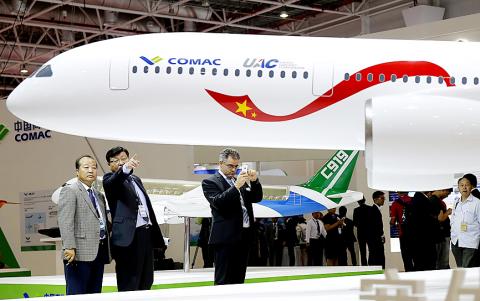China and Russia are to invest up to US$20 billion to develop a long-haul, wide-bodied jet, reports and a company statement said yesterday, as Beijing seeks to challenge leading Western manufacturers Boeing Co and Airbus Group SE.
The hugely ambitious plan was first agreed between the Commercial Aircraft Corp of China (COMAC, 中國商飛) and Russia’s United Aircraft Corp (UAC) — whose products include the Sukhoi Superjet 100 — in June when Russian President Vladimir Putin met Chinese President Xi Jinping (習近平) in Beijing.
COMAC said in a statement that the joint venture, to be set up in Shanghai this year, would develop a 280-seat, wide-body plane with a range of 12,000km.

Photo: Reuters
That would put it in direct competition with Boeing’s 787 and the Airbus A350.
The project is worth between US$13 billion and US$20 billion, with each side contributing half, China’s state-run Global Times newspaper yesterday quoted UAC president Yury Slyusar as saying.
COOPERATION
“COMAC has outstanding technology and designs and we will not only cooperate in technology, but also in intellectual property,” Slyusar told the newspaper at the China Airshow in the southern city of Zhuhai, adding that the plane would be 10 percent cheaper than its competitors.
According to the companies’ Web sites, the list price of a 280-seat Airbus A350 is US$272.4 million, while a 290-seat Boeing 787 costs US$264.6 million.
Their putative China-Russian rival is to make its first flight in seven years’ time, COMAC said, with deliveries beginning three years later.
Developing commercial aircraft is an advanced technological challenge and previous Chinese aerospace projects have experienced lengthy delays.
COMAC said it would keep the project open and select global suppliers that are willing to “jointly shoulder risks.”
Beijing is looking to build up its domestic aerospace industry, with the sector among those highlighted in its “Made in China 2025” plan.
The country is expected to become the world’s largest aviation market, with its travelers taking to the skies in ever-growing numbers.
DEVELOPMENTS
Airbus estimates China will need nearly 6,000 new planes worth US$945 billion in the next two decades, with Boeing’s forecast even more optimistic at more than US$1 trillion.
COMAC is also developing its own single-aisle jet, the C919. It rolled it out last year and even though it has yet to make its first flight COMAC says it has so far received 570 orders from 23 customers.
The firm’s regional jet, the 90-seat ARJ21, flew its first commercial flight in June after years of delays.

SEEKING CLARITY: Washington should not adopt measures that create uncertainties for ‘existing semiconductor investments,’ TSMC said referring to its US$165 billion in the US Taiwan Semiconductor Manufacturing Co (TSMC, 台積電) told the US that any future tariffs on Taiwanese semiconductors could reduce demand for chips and derail its pledge to increase its investment in Arizona. “New import restrictions could jeopardize current US leadership in the competitive technology industry and create uncertainties for many committed semiconductor capital projects in the US, including TSMC Arizona’s significant investment plan in Phoenix,” the chipmaker wrote in a letter to the US Department of Commerce. TSMC issued the warning in response to a solicitation for comments by the department on a possible tariff on semiconductor imports by US President Donald Trump’s

The government has launched a three-pronged strategy to attract local and international talent, aiming to position Taiwan as a new global hub following Nvidia Corp’s announcement that it has chosen Taipei as the site of its Taiwan headquarters. Nvidia cofounder and CEO Jensen Huang (黃仁勳) on Monday last week announced during his keynote speech at the Computex trade show in Taipei that the Nvidia Constellation, the company’s planned Taiwan headquarters, would be located in the Beitou-Shilin Technology Park (北投士林科技園區) in Taipei. Huang’s decision to establish a base in Taiwan is “primarily due to Taiwan’s talent pool and its strength in the semiconductor

An earnings report from semiconductor giant and artificial intelligence (AI) bellwether Nvidia Corp takes center stage for Wall Street this week, as stocks hit a speed bump of worries over US federal deficits driving up Treasury yields. US equities pulled back last week after a torrid rally, as investors turned their attention to tax and spending legislation poised to swell the US government’s US$36 trillion in debt. Long-dated US Treasury yields rose amid the fiscal worries, with the 30-year yield topping 5 percent and hitting its highest level since late 2023. Stocks were dealt another blow on Friday when US President Donald

UNCERTAINTY: Investors remain worried that trade negotiations with Washington could go poorly, given Trump’s inconsistency on tariffs in his second term, experts said The consumer confidence index this month fell for a ninth consecutive month to its lowest level in 13 months, as global trade uncertainties and tariff risks cloud Taiwan’s economic outlook, a survey released yesterday by National Central University found. The biggest decline came from the timing for stock investments, which plunged 11.82 points to 26.82, underscoring bleak investor confidence, it said. “Although the TAIEX reclaimed the 21,000-point mark after the US and China agreed to bury the hatchet for 90 days, investors remain worried that the situation would turn sour later,” said Dachrahn Wu (吳大任), director of the university’s Research Center for